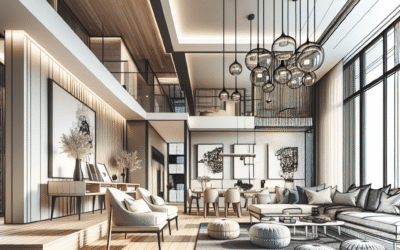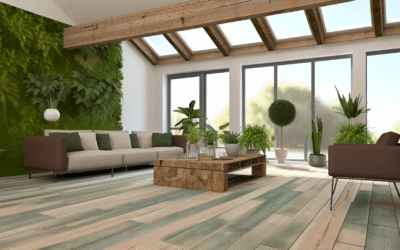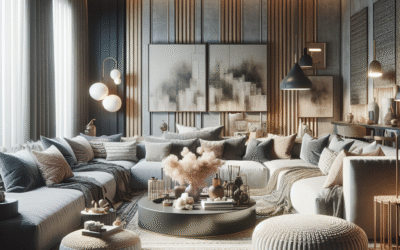
Color Theory for Living Rooms: Finding the Perfect Balance for Your Space
Understanding Color Theory
Color theory forms the foundation of how we perceive and interact with our spaces. By understanding the meanings and relationships of colors, we can create a living room that feels harmonious and inviting. In the following sections, we will explore the key elements of color theory—hues, saturation, and brightness—so you can find the perfect balance for your living room.
What is Color Theory?
Color theory is a collection of rules and guidelines on how to use color effectively. It encompasses the color wheel, color harmonies, and psychological effects of colors. Understanding color theory enables homeowners to choose colors that suit their tastes while evoking the desired atmosphere.
Components of Color
Colors can be broken down into three main components: hue, saturation, and brightness. Each component plays a crucial role in how colors are perceived in a room.
Choosing the Right Color Palette for Your Living Room
Your color palette sets the tone for your entire living space. It’s essential to choose colors that not only match your personal style but also create balance and harmony.
Monochromatic Schemes
A monochromatic color scheme uses variations of a single hue. This approach creates a cohesive and elegant look, making it an excellent choice for a serene living room.
Complementary Colors
Complementary colors are those that sit opposite each other on the color wheel. For example, blue and orange create a vibrant, energetic space. Use complementary colors to add visual interest.
Analogous Colors
Analogous color schemes use colors that sit next to each other on the color wheel. This creates a nurturing and harmonious feel, perfect for a cozy living room.
The Psychological Effects of Colors
Colors have the power to evoke emotions and influence mood. Understanding their psychological effects can help you select the perfect colors for your living room.
Warm Colors
Warm colors like reds, oranges, and yellows can create a sense of warmth and comfort. However, they can also stimulate energy, making them suitable for social spaces.
Cool Colors
Cool colors such as blues and greens are calming and soothing. They can create a peaceful environment, ideal for relaxation in your living room.
Lighting and Color Interaction
The lighting in your living room can significantly affect how colors appear. Natural and artificial light can change the way we perceive color, influencing your color choices.
Natural Light
Using colors in a room with abundant natural light can brighten the space and make colors pop. Warm colors can appear softer, while cool colors can feel refreshing.
Artificial Lighting
Different types of artificial lighting can also affect color perception. Soft white bulbs may make colors feel warmer, while cool white bulbs may enhance blues and greens.
Integrating Color with Decor
Your decor plays a vital role in how color is experienced in your living room. Consider these tips to integrate color with your furnishings and accessories.
Wall Color Choices
When selecting wall colors, consider the size of the room. Lighter shades can make a space feel larger, while darker shades can make it more intimate.
Accent Pieces
Accent pieces like cushions, rugs, and artwork can provide pops of color without overwhelming the space. Choose colors that complement your walls and furniture.
Case Study: Transforming a Living Room with Color
Let’s illustrate the effective use of color theory through a case study. Jane needed to refresh her living room for a more inviting ambiance. After analyzing the space, she chose a warm beige for the walls, accented with navy blue cushions and mustard yellow artwork. This combination generated warmth and energy, making her living room a favorite gathering spot.
Common Mistakes to Avoid
When it comes to choosing colors for your living room, there are common pitfalls to avoid. Here are a few:
- Overuse of bold colors, which can be overwhelming.
- Ignoring the effects of lighting on colors.
- Failing to create a cohesive color story.
Conclusion: Achieving Balance in Your Living Room
Building your dream living room is a rewarding journey. It starts with understanding color theory and how you can apply it to create the perfect balance for your space. From picking the right palette to integrating decor, each choice shapes the atmosphere of your home.
Now that you’re equipped with the knowledge of color theory, it’s time to take action! Transform your living room into the inviting space you’ve always desired.
For further reading, check out our articles on Interior Design Tips and Understanding Color Psychology.
FAQs
What are the best colors for a small living room?
Light colors such as whites, creams, and pastels can make a small living room feel larger and more open.
How can I choose a color scheme?
Start by selecting a base color, then choose complementary or analogous colors for accents and decor.
Does wall color affect mood?
Yes, colors can evoke emotions; warm colors tend to energize while cool colors promote calmness.
Can I mix different color schemes?
Yes, mixing color schemes can create depth. Just ensure the colors are harmoniously balanced.
What is the 60-30-10 rule in interior design?
This rule suggests using 60% of a dominant color, 30% of a secondary color, and 10% of an accent color to achieve balance.
Content Disclaimer
The information provided in this article is for educational purposes only and is not a substitute for professional advice.
Categories
- Accent Walls & Ceilings (61)
- Art Curation & Gallery (62)
- Bedding Style Trends (68)
- Bedroom Makeover (81)
- Bohemian & Eclectic Styles (58)
- DIY & Budget-Friendly Decor (64)
- Eco-Friendly Design (62)
- Furniture Care (71)
- Home Decor & Design Ideas (162)
- Home Wellness Spaces (59)
- Integrated Outdoor Living (67)
- Japandi Style (61)
- Kids and Nursery Decor (59)
- Living Room Decor (79)
- Mix & Match Techniques (73)
- Modern & Contemporary Design (66)
- Rug Sizing & Placement (73)
- Scandinavian Design Inspiration (20)
- Seasonal Home Decor (79)
- Small Space Solutions (73)
- Wall Art & Painting Tips (77)
Recent Comments
Archives
Product Gallery
-
Large Area Green Rugs for Bedroom Nordic Living Room Decoration Shaped Carpet Irregular Plush Lounge Rug Home Thick Washable Mat
Rated 5.00 out of 5$36.00 – $225.00Price range: $36.00 through $225.00 -
Nordic Style Rugs for Bedroom Morandi Living Room Decoration Carpet Large Area Geometry Lounge Rug Home Cloakroom Non-slip Mat
Rated 5.00 out of 5$26.00 – $387.00Price range: $26.00 through $387.00 -
Irregular Shapes Living Room Decoration Carpet Modern Style Rugs for Bedroom Home Thicken Plush Rug Fluffy Soft Lounge Floor Mat
Rated 4.83 out of 5$37.00 – $225.00Price range: $37.00 through $225.00














